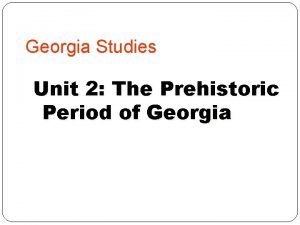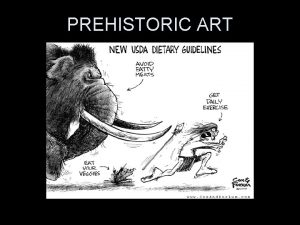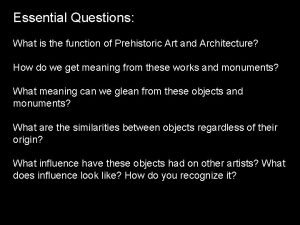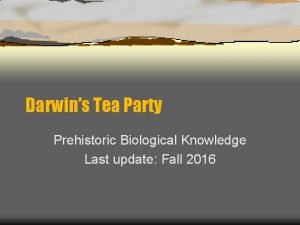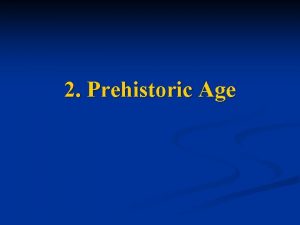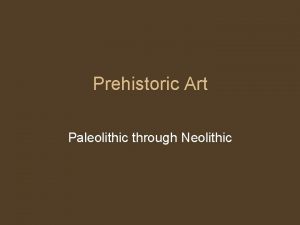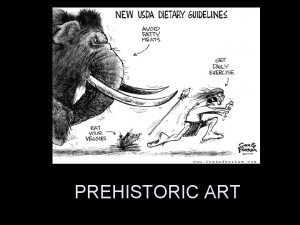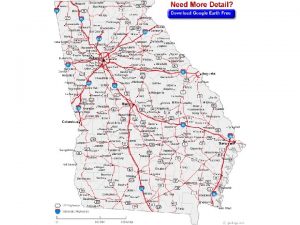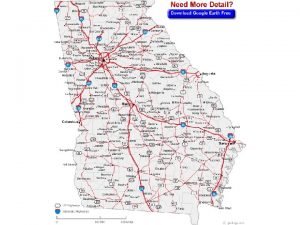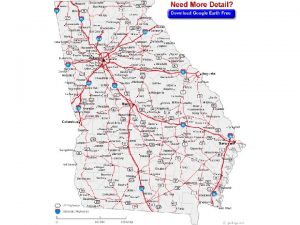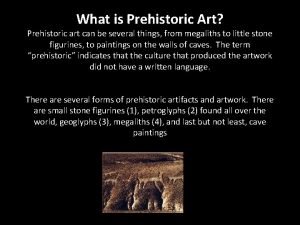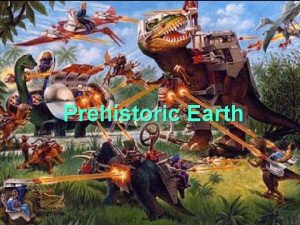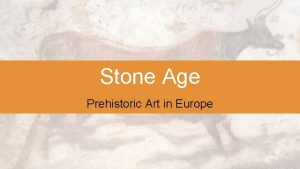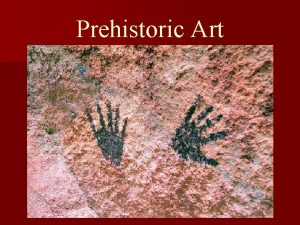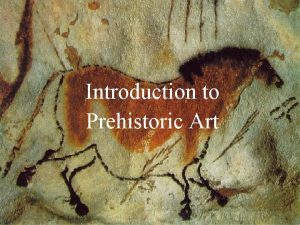Georgia Studies Unit 2 The Prehistoric Period of

















- Slides: 17

Georgia Studies Unit 2: The Prehistoric Period of Georgia

STANDARD The student will evaluate the development of Native American cultures and the impact of European exploration and settlement on the Native American cultures in Georgia

ESSENTIAL QUESTIONS What are some of the changes in Native American culture throughout their existence? What were the major characteristics of the Paleo, Archaic, Woodland, and Mississippian Periods?

Directions for notes: You are going to create a chart that will document the changes in the Native American cultures through the passage of time. NAME (PAWM) PALEO ARCHAIC WOODLAND MISSISSIPPI AN DATE LIFESTYL E TECHNOLOGY FOOD ADDITIONA L FACTS

Early Migration • Migration – movement of people from one place to another. • The first people migrated to North America between 30, 000 BC to 10, 000 BC. • During this time the world was experiencing an ice age. • The extra ice, at the North and South poles, lowered ocean levels. The Bering Land Bridge

• This created a land bridge (Bering Strait) that made it possible for people to walk from Asia to North America. • As the ice melted, the ocean levels rose and covered the land bridge separating people on different continents.

Paleo Period • the earliest known people to live in what is today Georgia (12, 000 - 8, 000 BCE); also called Old Stone Age • relied heavily on the Savannah, Ocmulgee, and Flint Rivers for survival, food, and travel • nomadic hunters & gatherers • Primary weapons were spears or Clovis points, made of wood, stone, or flint • Homes made from animal skins; made migration easy • Paleo means “very old”

• Mainly hunted Mammoths, Mastodons, Bison, Ground Sloth, Caribou, and Moose • Archaeologists have found two Paleo skeletons buried with artifacts and covered with red powder. • Archaeologists believe that this may indicate a belief in an afterlife and/or religious beliefs.

Archaic Period • 8000 BCE to 1000 BCE • Nomadic; as larger game became extinct the Archaic people began to hunt smaller game • Made technological advances like the atlatl that allowed spears to be thrown faster • Also invented grooved axes, pottery, hooks and fishing nets • migrated less and began to living in semi-permanent shelters (huts made of sticks and other natural materials) arranged in small villages • Began using fire to cook food and for warmth

During the middle Archaic Period there was a significant change in climate; warmer, drier weather Due to better weather, Archaic people were able to stay in one place longer During the late Archaic period, horticulture (the science of growing plants and trees) allowed the Archaic to be less nomadic they were able to grow most of their necessary food

• burial of the dead began to become important • tools, weapons, and body ornaments have been found in some burial pits • many Archaic settlements were near the Savannah River • They were often divided into 3 distinct periods; Early, Middle, and Late

Woodland Period • 1000 BC to 1000 AD • developed more advanced villages built in circular arrangements • people began grouping together to form tribes (a group of people who share a common identity due to their culture) • developed longer lasting, more advanced ceramic cooking pots and pottery • formed trading networks throughout modern day Midwestern U. S.

better horticulture methods allowed the Woodland people to introduce important crops like corn, squash, and greens hunting became easier due to a new weapon called the bow and arrow began building dome shaped mounds for ceremonies and burials adorned bodies with jewelry may indicate a belief in an afterlife or some form of religious beliefs fortified settlements suggests that tribes felt the need for protection from enemy attacks

Mississippian Period • 800 AD to 1600 AD • The Mississippian Period was the last period in Native American history before European exploration began. • The Mississippian people continued to live in tribes, in permanent shelters and villages. • Tribes began to join together during this time period and formed larger nations (allowed for division of labor and increased protection and safety).

• The knowledge of agriculture (horticulture) continued • • to increase allowing the tribes to grow a wide variety of crops (corn, squash, and beans) Mississippian’s also began storing extra food for future use Due to the division of labor the Mississippian people had more time to dedicate to the arts (advanced pottery, jewelry, and clothing). continued to improve wattle and daub houses (wood and clay) began to protect their villages through the use of moats and wooden walls

• improved upon the bow and arrow as the main tool • • • for hunting and for defense. the Mississippian’s developed a class structure where people were identified as belonging to an elite or lower class they developed stone axes, bowls, pipes, pottery, and tattoos continued to build burial mounds and religious centers Etowah Indian Mounds can be seen in Cartersville, Georgia Mississippian’s began to mysteriously decline between 1350 and 1600 AD.

Native American Cultures Summary There were four primary Native American tribes in Georgia prior to the arrival of Europeans: Paleo, Archaic, Woodland, Mississippian The economic system used by many of these tribes was a traditional economy; an underdeveloped economy that often depends on agriculture as its main base. The technology developed by these tribes allowed them to settle in one area longer and, due to agriculture, find alternative sources of food.
 Difference between historic period and prehistoric period
Difference between historic period and prehistoric period Georgia's prehistoric cultures chart
Georgia's prehistoric cultures chart Brain wrinkles
Brain wrinkles Paradigm shift from women studies to gender studies
Paradigm shift from women studies to gender studies Prehistoric art notes
Prehistoric art notes Function of prehistoric art
Function of prehistoric art Prehistoric era
Prehistoric era Prehistoric tasmanian devil
Prehistoric tasmanian devil Ancient art 30 000 b.c.–a.d. 400
Ancient art 30 000 b.c.–a.d. 400 Prehistoric monument dan word
Prehistoric monument dan word Light speed mps
Light speed mps Prehistoric era
Prehistoric era Prehistoric era
Prehistoric era 4 humors
4 humors Jiahu
Jiahu What did prosimians evolve from
What did prosimians evolve from Horse evolution fossils
Horse evolution fossils Prehistoric medicine
Prehistoric medicine

